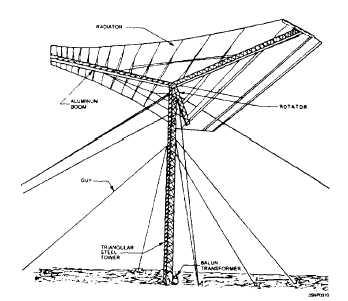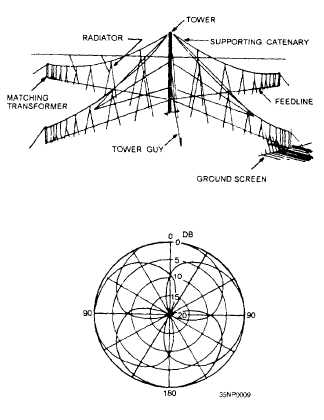cover a frequency range of 2 to 30 MHz requires one
tower approximately 140 feet high and an antenna
length of around 500 feet, with a ground system that
covers approximately 3 acres of land in the immediate
vicinity of the antenna.
Sector Log-Periodic Array
This version of a vertically polarized fixed-azimuth
LPA consists of four separate curtains supported by
a common central tower, as shown in figure 2-17.
Each of the four curtains operates independently,
providing antennas for a minimum of four transmit
or receive systems. and a choice of sector coverage.
The four curtains are also capable of radiating a rosette
pattern of overlapping sectors for full coverage, as
shown by the radiation pattern in figure 2-17. The
central supporting tower is constructed of steel and
may range to approximately 250 feet in height, with
the length of each curtain reaching 250 feet, depending
on its designed operating frequencies. A sector antenna
that uses a ground plane designed to cover the entire
hf spectrum takes up 4 to 6 acres of land area.
Figure 2-17.—Sector LPA and its horizontal radiation
pattern.
Figure 2-18.—Rotatable log-periodic antenna.
Rotatable LPA (RLPA)
RLPAs (fig. 2-18) are commonly used in
ship-to-shore-to-ship and in point-to-point ecm-u-nunica-
tions. Their distinct advantage is their ability to rotate
360 degrees. RLPAs are usually constructed with
either tubular or wire antenna elements. The RLPA
in figure 2-18 has wire elements strung on three
aluminum booms of equal length, spaced equally and
arranged radially about a central rotator on top of a
steel tower approximately 100 feet high.
The
frequency range of this antema is 6 to 32 MHz. The
gain is 12 dB with respect to isotropic antennas.
Power handling capability is 20 kw average, and vswr
is 2:1 over the frequency range.
INVERTED CONE ANTENNA
Inverted cone antennas are vertically polarized,
omnidirectional, and have an extremely broad
bandwidth. They are widely used for ship-to-shore
and ground-to-air communications. Inverted cone
antennas are installed over a radial ground plane
system and are supported by poles, as shown in figure
2-19. The equally-spaced vertical radiator wires
terminate in a feed ring assembly located at the bottom
center, where a 50-ohm coaxial transmission line feeds
the antenna. Inverted cones usually have gains of 1
to 5 dB above isotropic antennas, with a vswr not
2-10




